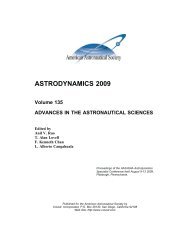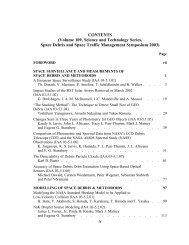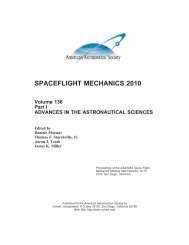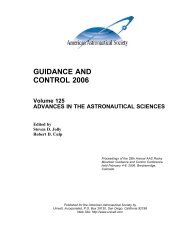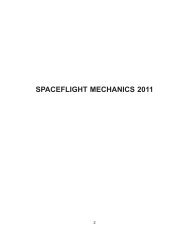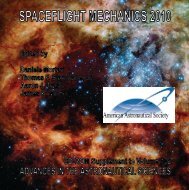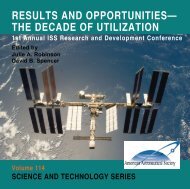information. - Univelt
information. - Univelt
information. - Univelt
- No tags were found...
You also want an ePaper? Increase the reach of your titles
YUMPU automatically turns print PDFs into web optimized ePapers that Google loves.
AAS 12-017DESIGN OF SPACECRAFT MISSIONSTO REMOVE MULTIPLE ORBITAL DEBRIS OBJECTSBrent W. Barbee, * Salvatore Alfano, † Elfego Piñon, ‡Kenn Gold § and David Gaylor **The amount of hazardous debris in Earth orbit has been increasing, posing anever-greater danger to space assets and human missions. In January of 2007, a ChineseASAT test produced approximately 2600 pieces of orbital debris. In February of 2009,Iridium 33 collided with an inactive Russian satellite, yielding approximately 1300pieces of debris. These recent disastrous events and the sheer size of the Earth orbitingpopulation make clear the necessity of removing orbital debris. In fact, experts fromboth NASA and ESA have stated that 10 to 20 pieces of orbital debris need to be removedper year to stabilize the orbital debris environment. However, no spacecraft trajectorieshave yet been designed for removing multiple debris objects and the size ofthe debris population makes the design of such trajectories a daunting task. Designingan efficient spacecraft trajectory to rendezvous with each of a large number of orbitaldebris pieces is akin to the famous Traveling Salesman problem, an NP-complete combinatorialoptimization problem in which a number of cities are to be visited in turn.The goal is to choose the order in which the cities are visited so as to minimize the totalpath distance traveled. In the case of orbital debris, the pieces of debris to be visitedmust be selected and ordered such that spacecraft propellant consumption is minimizedor at least kept low enough to be feasible. Emergent Space Technologies, Inc. has developedspecialized algorithms for designing efficient tour missions for near-Earth asteroidsthat may be applied to the design of efficient spacecraft missions capable of visitinglarge numbers of orbital debris pieces. The first step is to identify a list of high prioritydebris targets using the Analytical Graphics, Inc. SOCRATES website and thenobtain their state <strong>information</strong> from Celestrak. The tour trajectory design algorithms willthen be used to determine the itinerary of objects and Äv requirements. These resultswill shed light on how many debris pieces can be visited for various amounts of propellant,which launch vehicles can accommodate such missions, and how much margin isavailable for debris removal system payloads. [View Full Paper]* Aerospace Engineer, NASA GSFC, Code 595, 8800 Greenbelt Road, Greenbelt, Maryland 20771, U.S.A.† Senior Research Astrodynamicist, Center for Space Standards and Innovation (CSSI), 7150 Campus Drive, Suite260, Colorado Springs, Colorado 80920, U.S.A.‡ Senior GN&C Engineer, Emergent Space Technologies, Inc., 6411 Ivy Lane, Suite 303, Greenbelt, Maryland20770, U.S.A.§ Director of R&D, Emergent Space Technologies, Inc., 6411 Ivy Lane, Suite 303, Greenbelt, Maryland 20770,U.S.A.** Vice President, Emergent Space Technologies, Inc., 6411 Ivy Lane, Suite 303, Greenbelt, Maryland 20770,U.S.A.8



